 Weird Stuff
Weird Stuff  Weird Stuff
Weird Stuff  Politics
Politics 10 Political Scandals That Sent Crowds Into the Streets
 Weird Stuff
Weird Stuff Ten Bizarre Facts About The Doge Meme
 Our World
Our World 10 Ways Your Christmas Tree Is More Lit Than You Think
 Movies and TV
Movies and TV The 10 Coolest Stars to Set Sail on The Love Boat
 History
History 10 Things You Didn’t Know About the American National Anthem
 Technology
Technology Top 10 Everyday Tech Buzzwords That Hide a Darker Past
 Humans
Humans 10 Everyday Human Behaviors That Are Actually Survival Instincts
 Animals
Animals 10 Animals That Humiliated and Harmed Historical Leaders
 History
History 10 Most Influential Protests in Modern History
 Weird Stuff
Weird Stuff 10 Funny Ways That Researchers Overthink Christmas
 Politics
Politics 10 Political Scandals That Sent Crowds Into the Streets
 Weird Stuff
Weird Stuff Ten Bizarre Facts About The Doge Meme
Who's Behind Listverse?

Jamie Frater
Head Editor
Jamie founded Listverse due to an insatiable desire to share fascinating, obscure, and bizarre facts. He has been a guest speaker on numerous national radio and television stations and is a five time published author.
More About Us Our World
Our World 10 Ways Your Christmas Tree Is More Lit Than You Think
 Movies and TV
Movies and TV The 10 Coolest Stars to Set Sail on The Love Boat
 History
History 10 Things You Didn’t Know About the American National Anthem
 Technology
Technology Top 10 Everyday Tech Buzzwords That Hide a Darker Past
 Humans
Humans 10 Everyday Human Behaviors That Are Actually Survival Instincts
 Animals
Animals 10 Animals That Humiliated and Harmed Historical Leaders
 History
History 10 Most Influential Protests in Modern History
10 Puzzling Mysteries Solved By Science
Despite centuries of study, the universe remains largely mysterious, as does the planet we call home. The unknown inspires both wonder and curiosity, which, in turn, often prompt questions. Seeking answers, we gather facts, form hypotheses, and conduct observations or experiments. Sometimes, we remain puzzled. The causes of unlikely phenomena, of seemingly impossible developments, and of strange occurrences continue to mystify us.
At other times, however, we discover, we learn, and our knowledge expands. Nevertheless, new mysteries await. There are always more puzzles to solve. Each time we manage to unravel one of the mysteries of the universe, though, we are inspired again to seek more answers. We are a species with a need to know that can’t be satisfied, even when, through science, we manage to solve puzzling mysteries like the ten on this list.
10 Bizarre Unsolved Mysteries Of The World
10 Titan’s Waves
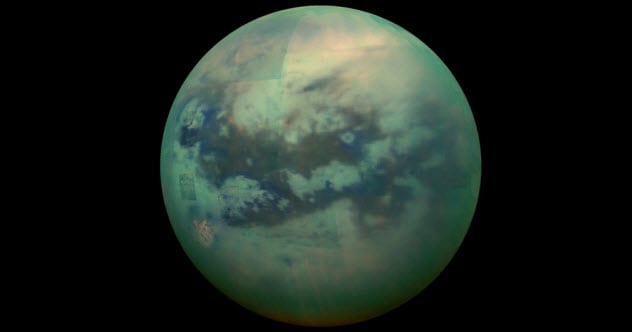
In many ways, Titan’s landscape looks like that of the Earth. Saturn’s moon has several “lakes . . . seas . . . [and] river channels.” However, these apparent bodies of water don’t contain water at all, nor were they carved by the running of water over eons of time. With surface temperatures as low as 290 degrees Fahrenheit below zero, Titan is much too cold—freezing, in fact—for water. Instead, scientists believe, a mix of liquid methane, ethane, and other freeze-resistant hydrocarbons are responsible for the apparent bodies of water.
Planetary scientists agree that the moon is a “wet world,” but they are mystified as to the reason that the lakes, seas, and river channels lack waves. After all, in addition to the moon’s low gravity, there is wind, as the moon’s plentiful sand dunes prove; therefore, there should be waves. Maybe the lakes are frozen. Maybe they’re “covered with a tar-like substance that damps wave motion.” These theories would account for the absence of waves, but new data suggest that these explanations are wrong.
There are waves, recent studies indicate. They just haven’t been visible because, during winter, the atmosphere is dense with “cold heavy air,” and the moon’s winds are too weak to move it—or to make waves. As the moon warms with the approach of summer, winds should strengthen and move fast enough to make waves detectable to radar. If so, Titan’s waves will help scientists to evaluate the climate conditions on Saturn’s moon and could indicate the “viscosity of the [waves’] underlying fluid” and its chemical make-up and help to determine “the speed of the overlying winds, providing an independent check of Titan climate models.” Mystery solved![1]
9 Greenland’s “Dark Zone”
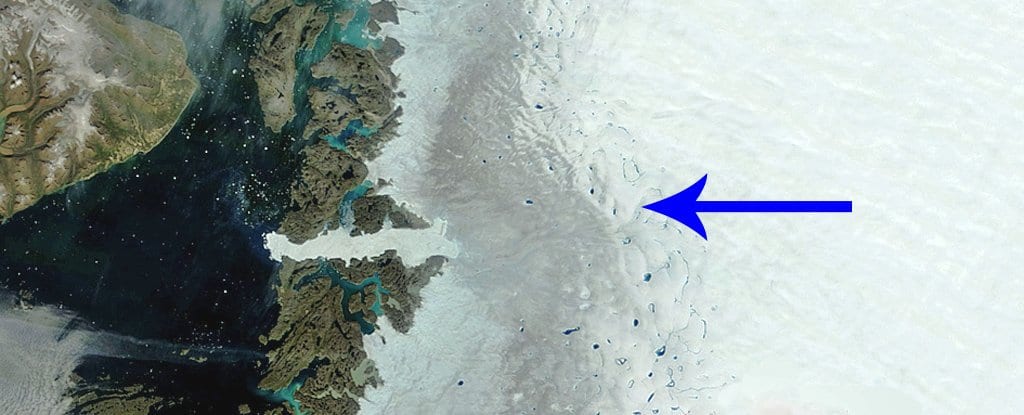
Until summer, Greenland’s ice sheet, as viewed from the air, looks like an immense, bright white expanse. Then, as temperatures increase, the western edge of the field becomes dark, as algae grow there. This so-called dark zone has become increasingly larger in recent years. Scientists wanted to know why. What was causing the increase in algae?
The ice sheet covers much of the world’s largest island—1.71 million square kilometers (656,00 square miles), to be exact, which is three times the size of the state of Texas, and the sheet’s a mile thick! It may not be that size much longer, though. It’s in “permanent retreat . . . losing 500 gigatons (500 billion tons) of ice every year.” The increase in the size of the dark zone has a lot to do with the decrease in the ice sheet’s dimensions, scientists have found.
The mystery behind the surge in the growth of the algae that comprise the dark zone has now been solved. It’s caused by the layer of carbon and phosphorus-rich dust that covers the area. This layer of particulates reduces the amount of sunlight the ice sheet reflects into space, causing the ice to warm, and, in the spring, the ice melts, and the dormant algae “migrate to the surface,” where they benefit from “24-hour sunlight,” which enables the plants to photosynthesize and grow, as their green colors darken to protect the algae from the “constant sunlight.” The plants’ growth is further facilitated by the phosphorus-rich dust that’s locally supplied “from hydroxylapatite—a phosphate mineral that also contains calcium, oxygen, and hydrogen—that gets blown across the ice as dust from exposed rocky outcrops.”
The solution to the mystery of the dark zone’s growth should help scientists track the rate at which Greenland’s ice sheet melts, since the warmer atmosphere promotes greater deposits of phosphorus from local rocks, which, drier, expose more phosphorous, which, in turn, provides more nutrients to the algae, which then increasingly warms the ice, creating a continuing cycle.[2]
8 Antarctica’s Blood Falls
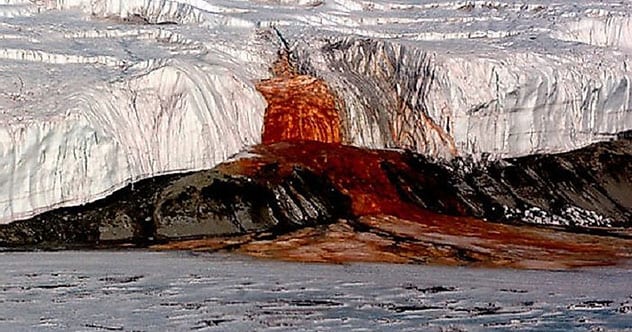
An eerie red river runs across Taylor Glacier in east Antarctica. At the mouth of the glacier, the river tumbles over a cliff, into Lake Bonney, looking exactly like its name, Blood Falls. What caused the strange appearance of this mysterious blood-red river? This question has mystified scientists since its discovery in 1911. Originally, algae were considered the culprits, but this hypothesis was never verified.
What has been discovered by scientists associated with the University of Alaska Fairbanks is that “oxidized iron in brine water” gives Blood Falls its unusual color as the iron in the saltwater, making contact with oxygen in the air, oxidizes—in effect, rusts—and “dyes” the water red. The saltwater makes its way to the edge of the glacier from an underground lake, as pressure forces the water through the glacier’s “fissures and channels,” in a journey that takes 1.5 million years.
The water wouldn’t flow at all, of course, if it were frozen, but it avoids freezing because “latent heat associated with water freezing,” the water’s super-saturation in salt, and “the high pressures at the base of the glacier” maintain the saltwater at temperatures above freezing.[3]
7 Parasaurolophus Skull
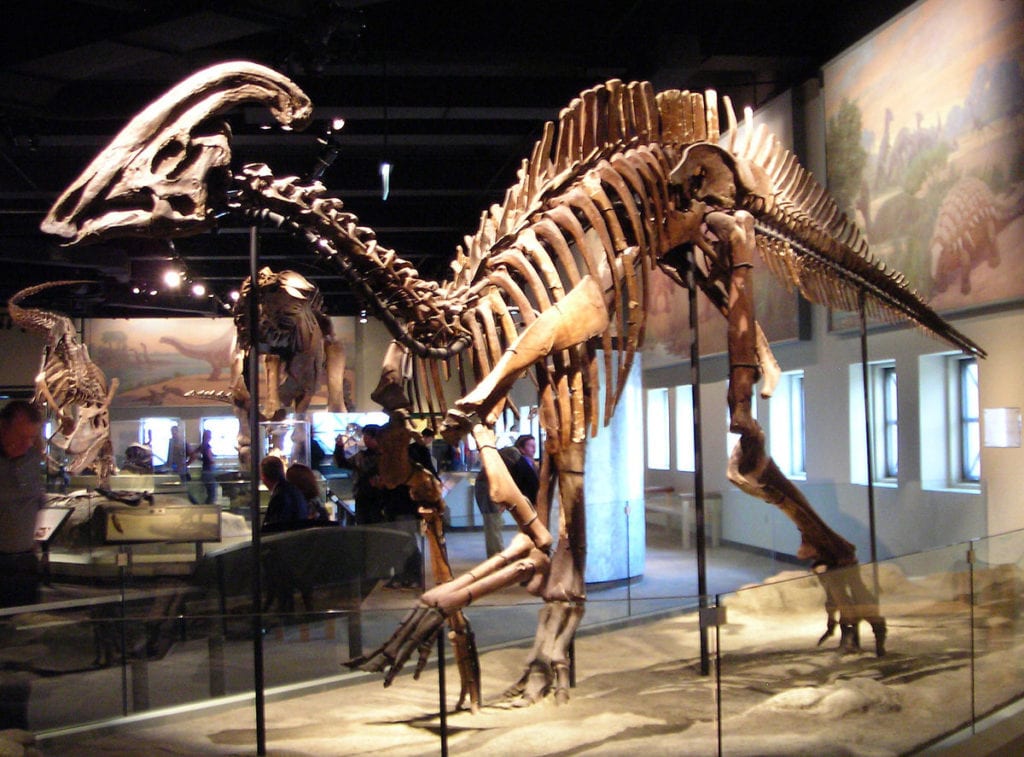
Paleontology is far from an exact science, as the myriad of qualifications that readers of texts concerning this field of research encounter clearly suggests. Debates are plentiful and, often, long-term. Such was the case with regard to how the skulls of the Parasaurolophus ever managed to grow on the heads of the rare species of dinosaur; disputations and arguments lasted decades.
The unusual skull includes an “exaggerated tube crest” that grows along the center of the front of the animal’s face and houses the dinosaur’s nasal passage, including its nostrils. “Imagine your nose growing up your face, three feet behind your head, then turning around to attach above your eyes,” paleontologist Terry Gates says, noting “Parasaurolophus breathed through eight feet of pipe before oxygen ever reached its head.”
Was the strange protuberance, which forms “much like other related duck-billed dinosaurs,” a “snorkel”? A “super sniffer”? These explanations were put forward once, but, now, scientists have solved the mystery of the tube crests. They were “sound resonators and visual displays used to communicate within their own species” at a time, 75 million-years ago, when, as the Denver Museum of Nature and Science explains, “a narrow sea” separated the North American continent.[4]
6 Train Millipede Swarms
Although, officially, they are known as Parafontaria laminata armigera, the poisonous arthropods indigenous to Japan are colloquially called “train millipedes” because they swarm in such numbers that they stop trains in—or on—their tracks. First observed in 1920, the millipedes would teem across railroad tracks in Japan’s “forested mountains” in numbers so thick that trains would have to halt. Then, they wouldn’t be seen again for eight years, when they’d return, once again bringing trains to a standstill. The phenomenon remained a mystery until Keiko Niijima, a researcher at the Forestry and Forest Products Research Institute, figured it out. The millipedes weren’t somehow attracted to train tracks. They were just traveling to new “feeding grounds” that happened to lie on the other side of the tracks.
Their life cycle is eight years long, during which the whole population of the poisonous millipedes experience “the phases of life at the same time.” They are the only “non-insect” arthropod to have evolved this eight-year, synchronous life cycle. Adults and seventh nymphs (those on the stage of the life cycle that is just before that of adulthood) are so numerous that they consume everything they can and have to relocate to find more of the “dead or decaying leaves” on which their diet depends. The millipedes are unusual because of their defensive capability as well; should a predator attack, the millipedes release a powerful poison—cyanide.[5]
Top 10 Puzzling Island Mysteries
5 Rogue Orca Attacks
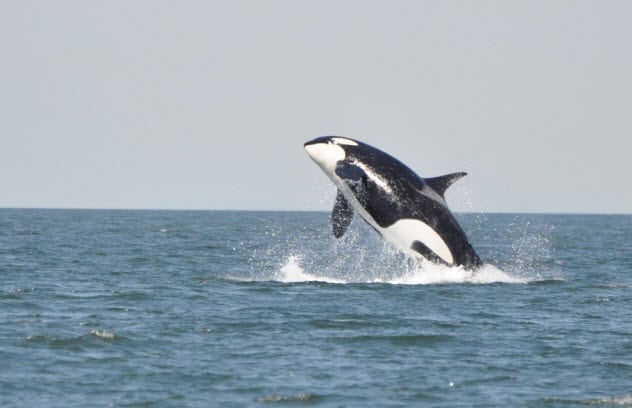
Boats afloat off the coast of Spain have come under attack by rogue orcas. Some of the assaults are fierce. On September 22, 2020, a yacht lost its rudder when it came under attack by three orcas. The owner of the 45-foot vessel, Graeme Walker, recalled, “The boat would . . . spin through 90 degrees when the animals came in. . . . When they actually bit on the rudder and started shaking [it] the wheel was spinning from side to side. You could not have touched it. You would have broken your arms.” The same day that the whales battered Walker’s yacht, Spain’s Ministry of Transport, Mobility and Urban Agenda announced a protective measure. Boats under fifty feet long were banned from sailing between Cabo Prioriño Grande and Punta de Estaca de Bares, the location of the whales’ attacks.
The reason for the whale’s aggression remained a mystery until researchers analyzed footage of the attacks of a few of the killer whales, all of which were young. Two appeared to have been “seriously injured.” Although it was unclear whether their injuries were sustained before or during the attacks, the researchers believe that, in either case, the animals felt threatened, which probably explains their hostility.[6]
4 Cell Bones
Cells don’t really have bones, of course, but they do have structures that perform functions similar to such connective tissue. In both plants and animals, actin filaments, “thin, flexible protein strands,” support cells and cellular functions, growing, shrinking, bonding “with other things,” and branching off as cells move. How actin filaments form chains by linking together, a process known as polymerization, was a mystery to scientists—a mystery that simulations using supercomputers helped to solve.
Researchers discovered that an actin filament lengthens much more rapidly at one end of a strand than it does at the other. The end that lengthens less quickly acts as a “binding site,” making a quick connection that allows the polymerization reaction to continue. This ability enables cells to perform a variety of tasks. For example, Gregory Voth, the Haig P. Papazian Distinguished Service Professor at the University of Chicago, says that “when a cell wants to move forward, . . . it will polymerize actin in a particular direction. Those actin filaments then push on the cell membrane, which allow[s] the cell to move in a particular direction.” The improved knowledge of how actin filaments act has important and “wide-ranging” therapeutic medical applications.[7]
3 Flower Power

Charles Darwin couldn’t figure out how flowering plants first evolved, and he feared this “abominable mystery” might “undermine his theories of evolution.” Specifically, in an 1879 letter to his friend, Dr. Joseph Hooker, a botanist, Darwin admitted, “The rapid development as far as we can judge of all the higher plants within recent geological times is an abominable mystery.” How could flowering plants evolve so rapidly, when it had taken other living things, including mammals, a much longer time to do so? “Why isn’t there a gradual evolution of the angiosperms?” Darwin asked. “Why can’t we see intermediate forms between the gymnosperms—things like conifers—and the flowering plants? And why, when they appear, are they already so diverse?”
Scottish botanist William Carruthers used the “abominable mystery” to cast doubt on the theory of evolution, making claims about the “fossil record” that defenders of evolution were hard-pressed to address. Darwin, it seems, had good reason to fret about the quick appearance of angiosperms. According to Professor Richard Buggs, the “abominable mystery” remains unsolved to this day. What isn’t as puzzling, however, are the doubts that Darwin had about his own views on the evolution of life, even months before his death, and his fears that flowering plants might be the basis for challenging the very idea that life had developed as a series of adaptations to the environment over millions of years. The mystery of Darwin’s own thoughts about flower power and its possible effects on his own life’s work are now a mystery solved![8]
2 Geometric Droppings

The droppings of the bare-nosed wombat resemble charcoal briquettes. The nocturnal marsupial excretes as many as a hundred cubes of feces every day. How the wombat accomplishes this astonishing feat was a mystery. Now that scientists have unraveled the puzzle, they find the solution just as amazing. Sunghwan Jung, a biophysicist at Cornell University, wasn’t a member of the research team who found the answer, but the findings leave no doubt, he says, that the wombat’s intestines “are very special.”
The marsupials live in Australia’s “grassy plains and eucalyptus forests,” passing their days in tunnels and eating plants by night. To mark their territory, the animals leave their scat behind. Roadkill in the form of a wombat revealed part the answer concerning how the animals are able to produce cubes of dung. The wombat’s intestines contained “two grooves where the guts are more elastic.” The dissection of two additional wombats shed more light on the problem. A two-dimensional mathematical model of the animals’ guts indicated that the wombats’ “intestinal sections contract over several days, squeezing the [feces] as the gut [extracts] nutrients and water” from the excrement. “Stiffer portions” of the gut contract more rapidly, the soft areas more slowly, the latter molding “the final corners of the cube.”[9]
1 White Smudge
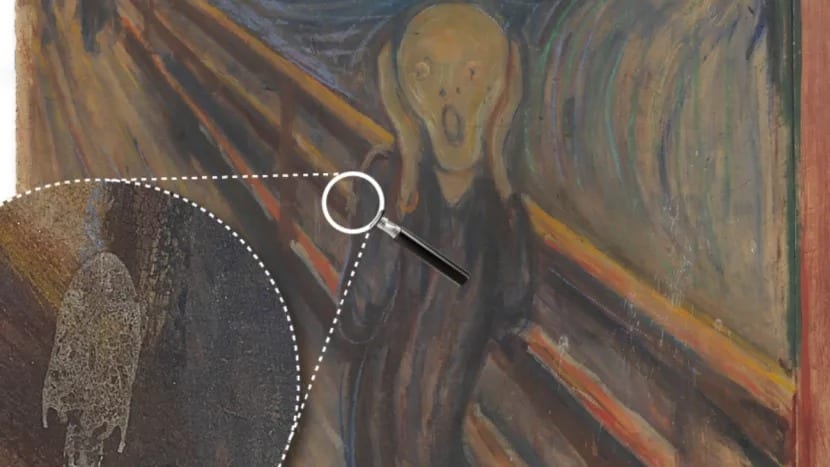
Located beside the figure’s right arm, on the lower rail of the fence behind him, a mysterious white stain is discernible in one version of Edvard Munch’s famous painting, The Scream. Although the artist created four variants of the portrait of modern angst, one of which fetched £91 million (nearly 125 million U.S. dollars) in 2012, the most acclaimed one is displayed in the Norwegian National Museum. Unlike the other iterations of the work, this one includes several white splatters on its canvas.
Since Munch often painted outdoors, some believed the stain was the result of a bird perched or flying overhead. The white smudge, in other words, was avian excrement; a bird had defecated on the painting. Others believed the white smears to be chalk or paint that had somehow been deposited on the canvas as Munch was at work on the painting. When Professor Tine Frøysaker of the University of Oslo hired a team to determine the materials and techniques the artist had used in painting his subject, the Macro C-ray fluorescence scanner they used to test a sample of the mysterious white stain solved the mystery: the blemish was “molten wax,” the culprit “a candle in Munch’s studio,” graduate student Frederik Vanmeert, who analyzed the sample of the painting, reported.[10]
10 Reasons Why Ninja Will Always Be A Mystery
About The Author: An English instructor at the University of Nevada Las Vegas, Gary L. Pullman lives south of Area 51, which, according to his family and friends, explains “a lot.” His four-book series, An Adventure of the Old West, is available on Amazon.








